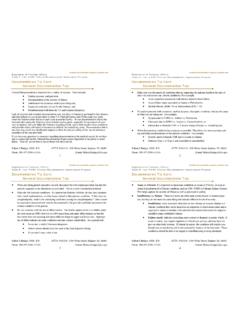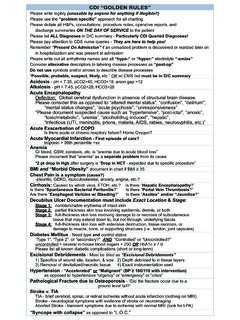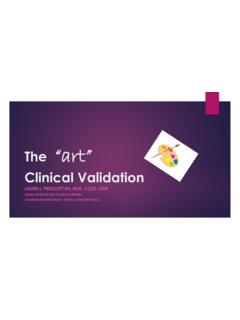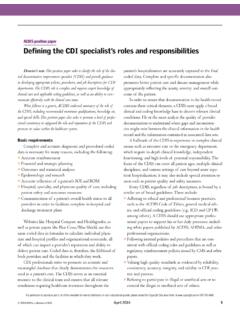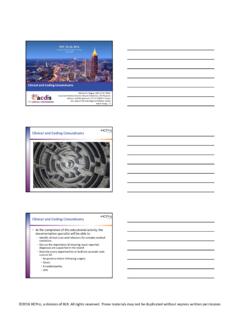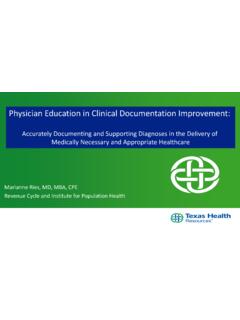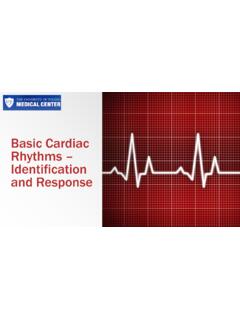Transcription of Hypercoagulable states - ACDIS
1 Hypercoagulable statesVladimir-Ducarmel Joseph, MD, MHAR egional Provider CDI EducationClinical Documentation Improvement4/25/2019 Vladimir-Ducarmel Joseph, MD, MHA CDI experience in both For-profit and Not-For-profit organizations. Regional Provider CDI Education Lead for Trinity Health Of New England. Special areas of interest include Physician Leadership, Team Dynamics, Clinical Documentation Improvement and clinical overview of Hypercoagulable states and related clinical and describe atrial fibrillation as a Hypercoagulable and describe the CDI and coding implicationsObjectives 2017 Trinity & of hemostasis & Virchow s Hypercoagulable state: common Hypercoagulable state: common & fibrillation: a Hypercoagulable , coding implications & clinical takeawaysPlan 2017 Trinity Health4 Provider:Hi!! How are you?CDIS:Good morning Dr. X. I saw that you answered the query on Mrs. B. Thank :Yeah. That HCS query?
2 You know that the patient has afib, right? That s why she is on :You are treating the afibwith the Coumadin?Provider:Not the afibper se. I am preventing DVT in this patient given her elevated risk of developing a clot from her persistent afibcombined with her DM and very low ejection fraction heart :Do you think all these risk factors present in this patient put her in a state where she becomes prone to developing clots?Provider:Well, you are rephrasing what I just :Does that mean this patient is in a Hypercoagulable state?Provider:Come to think of it, you may have a point. Tell me more about HCS in this it usually 2017 Trinity clinical overview of Hypercoagulable states and related clinical and describe atrial fibrillation as a Hypercoagulable and describe the CDI and coding implicationsObjective #1 2017 Trinity Health6 Patients are considered to have a Hypercoagulable state if they have laboratory abnormalities or clinical conditions that are associated with increased risk of thrombosis.
3 The hypercoagulablestates are a group of acquired and inherited disorders that increase the risk of abnormal development of blood clots. They are divided into: primary or inherited Hypercoagulable states secondary or acquired Hypercoagulable & overview 2017 Trinity Health7 Reference: The Hypercoagulable states by Schafer Al. hemostasis 2017 Trinity Health8 Normal hemostasis 2017 Trinity Health93 pathways: Tissue factor or extrinsic pathway Contact activation or intrinsic pathway Common pathwayCofactors: Calcium & phospholipid Vitamin KNormal hemostasis 2017 Trinity Health10 Regulators: Protein C Antithrombin Tissue factor pathway inhibitor Plasmin Prostacyclin (PGI2)Virchow s triad 2017 Trinity Health11A major theory delineating the pathogenesis of venous of VTE: Alterations in blood flow ( stasis) Vascular endothelial injury Alterations in the constituents of the bloodBlood constituentsabnormalitiesVessel Wall injuryBlood flowabnormalitiesThrombosisReference: Overview of the causes of venous thrombosis by Bauer & Lip, 2019 Virchow s triad 2017 Trinity Health12 A risk factor for thrombosis can now be identified in over 80 percent of patients with venous thrombosis.
4 There is often more than one factor at play in a given patient. Many patients with VTE fulfill most or all of Virchow's constituentsabnormalitiesVessel Wall injuryBlood flowabnormalitiesThrombosisReference: Overview of the causes of venous thrombosis by Bauer & Lip, 2019 Primary Hypercoagulable statesare inherited disorders of specific anticoagulant factors. The most frequent causes of an inherited Hypercoagulable states are: The factor V Leiden mutation The prothrombin gene mutation Primary Hypercoagulable states 2017 Trinity Health13 The following three account for most of the remaining cases: Defects in protein S Defects in protein C Defects in antithrombin (formerly known as antithrombin III)Primary Hypercoagulable states 2017 Trinity Health14 Reference: Protein C and S function in the termination of coagulation, UpToDate, 2019 Secondary Hypercoagulable states are primarily acquired disorders that predispose to thrombosis through complex and multifactorial mechanisms.
5 Common examples include: Previous thromboembolism. Previous thrombotic events are a major risk factor for recurrent VTE. In an outpatient prospective cohort study, the risk of recurrence after an acute episode of venous thrombosis was 18, 25, and 30 percent at two, five, and eight years, respectively. In a community-based epidemiologic study, a previous history of VTE conferred a relative risk (RR) of for VTE recurrence. Malignancy. Patients with cancer often have a Hypercoagulable state due to the production of substances with procoagulant activity ( tissue factor and cancer procoagulant). Clinical VTE occurs in approximately 15 percent of such patients and is common cause of serious clinical outcomes. Approximately 20 percent of patients with symptomatic deep venous thrombosis have a known active malignancySecondary Hypercoagulable states 2017 Trinity Health15 Reference: Overview of the causes of venous thrombosis by Bauer & Lip, 2019 More examples: Pregnancy.
6 Pregnancy is associated with an increased risk of thrombosis that may be due in part to obstruction of venous return by the enlarged uterus, as well as the Hypercoagulable state associated with pregnancy. Certain Drugs: Oral and transdermal contraceptives HRT Testosterone Tamoxifen Prolonged Immobilization. (prolonged sitting, extended travel) Surgery. Thrombotic risk is greatly increased during surgery, particularly orthopedic, major vascular, neurosurgery, and cancer Hypercoagulable states 2017 Trinity Health16 Bevacizumab Glucocorticoids AntidepressantsReference: Overview of the causes of venous thrombosis by Bauer & Lip, 2019 More examples: Major trauma. The mechanisms of activation of the coagulation system following surgery or trauma are incompletely understood as of this presentation, but may include decreased venous blood flow in the lower extremities, diminished fibrinolysis, immobilization, the release or exposure of tissue factor, and depletion of endogenous anticoagulants such as antithrombin.
7 Antiphospholipid antibodies. Renal diseases. (ESRD, nephrotic syndrome, renal transplantation). To better illustrate, using the Healthcare Cost and Utilization Project's Nationwide Inpatient sample, the annual frequency of pulmonary embolism in adults with end-stage renal disease, chronic kidney disease, and normal renal function was 527, 204, and 66 per 100,000 persons. Liver disease. Cardiovascular disease.(heart failure with very low EF, atrial fibrillation etc.)Secondary Hypercoagulable states 2017 Trinity Health17 Reference: Overview of the causes of venous thrombosis by Bauer & Lip, 2019 Many patients with an episode of VTE have more than one acquired risk factor for thrombosis. This was shown in a population-based study of the incidence of VTE in residents of Worcester, MA during 1999. The six most prevalent pre-existing medical characteristics of patients in this study were:-More than 48 hours of immobility in the preceding month (45%)-Hospital admission in the past three months (39%)-Surgery in the past three months (34%)-Malignancy in the past three months (34%)-Infection in the past three months (34%)-Current hospitalization (26%)Only 11 percent of the 587 episodes of VTE had none of these six characteristics present, while 36 and 53 percent had 1 to 2 and 3 risk factors, Hypercoagulable states 2017 Trinity Health18 Reference: Overview of the causes of venous thrombosis by Bauer & Lip, 2019 The diagnosis of Hypercoagulable state is based on clinical judgement and evaluation of the patient.
8 The tests that are ordered based on the history and examination of the patient. These tests can include: CBC PT PTT Thrombodynamicstest Thrombin time Lupus anticoagulant Anti-cardiolipinantibodyDiagnosis 2017 Trinity Health19 Anti-B2 glycoprotein-1 antibody Protein C resistance Fibrinogen tests Factor V Leiden Homocysteine levels Prothrombin mutationsThe treatment depends on the underlying cause. Regardless of the cause, the treatment will involve the use of anticoagulants such as heparin, warfarin, direct thrombin inhibitors (Argatroban), Xarelto, etc. In primary cases, the treatment is usually a maintenance therapy as there is no cure as of this presentation. In secondary cases, an effective correction of the underlying cause (nephrotic syndrome, atrial fibrillation, etc.) will reduce the associated 2017 Trinity clinical overview of Hypercoagulable states and related clinical and describe atrial fibrillation as a Hypercoagulable and describe the CDI and coding implicationsObjective #2 2017 Trinity Health21 Several studies that measured indices of coagulability suggest that atrial fibrillation confers a Hypercoagulable state, increasing the risk of thromboembolism and pathophysiology of thromboembolism in atrial fibrillation is multi-factorial but increasing evidence points to the fulfillment of Virchow's triad in this arrhythmia , leading to a prothrombotic or Hypercoagulable state.
9 Consideration must be given to the patient's age, the presence of structural heart disease, and clinical risk factors such as previous hypertension, diabetes, various biomarkers, or heart failure (particularly depressed left ventricular systolic function).Atrial fibrillation: a Hypercoagulable state 2017 Trinity Health22 Reference: Mechanisms of thrombogenesis in atrial fibrillation by Lip, 2017 Evidence of flow abnormalitiesis provided by the loss of atrial systole in atrial fibrillation that results in increased stasis of blood within the left atrium. Fast ventricular rate, which is often a consequence of that arrhythmia , reduces effective ventricular filling and further worsens intra-atrial of blood constituents abnormalitiesis provided by increased platelet activation in atrial fibrillation, which has been demonstrated in numerous of vessel wall abnormalitiesin AF is provided by the following observations:Atrial fibrillation: a Hypercoagulable state 2017 Trinity Health23 Reference: Atrial Fibrillation and the Hypercoagulable State: From Basic Science to Clinical Practice Endocardial damage and disorganization of the left atrial appendage endocardium has been described in the setting of mitral valve disease, especially where atrial fibrillation is present.
10 Abnormal plasma indices of endothelialdamage/dysfunction,such as vWf, which have been related to thrombogenesis, stroke risk, and adverse prognosis. Increased levels of Circulating Endothelial Cells (CECs), an index of endothelial damage in the setting of afiband target organ damage (heart failure, stroke, myocardial infarction).Atrial fibrillation: a Hypercoagulable state 2017 Trinity Health24 Reference: Atrial Fibrillation and the Hypercoagulable State: From Basic Science to Clinical Practice clinical overview of Hypercoagulable states and related clinical and describe atrial fibrillation as a Hypercoagulable and describe the CDI and coding implicationsObjective #3 2017 Trinity Health25 Hypercoagulable state (primary or secondary), when documented in the medical record is a CC and can, therefore, impact the length of stay, reimbursement, severity of illness and risk of mortality. Secondary Hypercoagulable state is often under documented and underreported.
